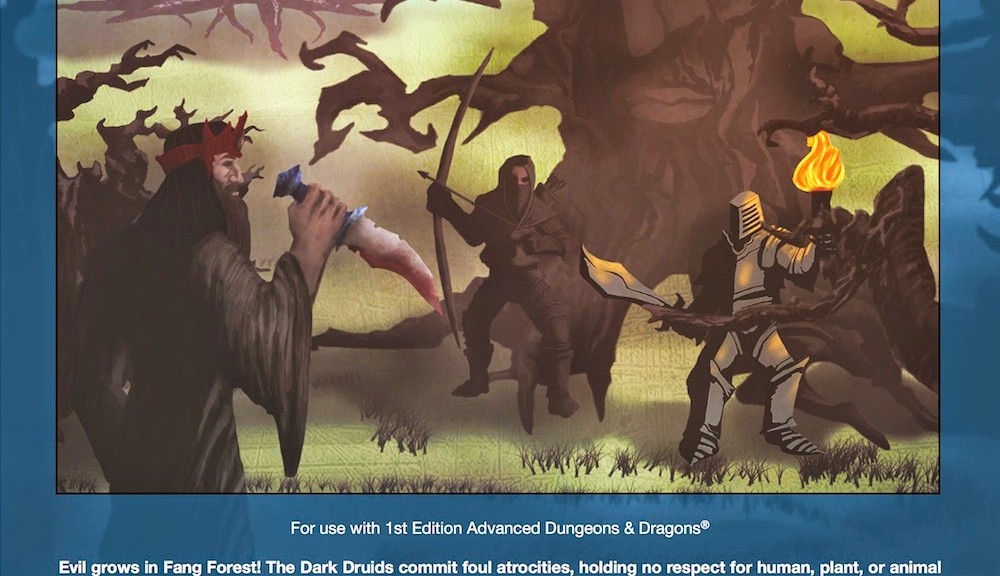Rob Kuntz’s Dark Druids was on sale a few weeks back. It arrived at the end of April. Since my submission to the 2015 One Page Dungeon Contest involved druids – The Dire Druids of Delver’s Deep, I waited until after I completed my submission to read this module. My planned postings got sidetracked, since I jumped on board the White Star bandwagon.
This module clearly states on the cover below the illustration: “For use with 1st Edition Advanced Dungeons & Dragons(R)”. Unlike others, it is not afraid to say this and also acknowledges that the name of the game is a registered trademark. It is one of three modules currently available from Chaotic Henchmen Productions.
The blurb from the back cover explains what this module is all about: “Dark Druids includes complete descriptions and maps for an outdoor area and a three-level adventure site, and is easily adaptable to most campaign settings. It also includes an outline for further adventuring, a selection of new monsters, spells, and magic items, plus Robert J. Kuntz’s historical context and commentary on this module’s relationship to his campaigns of the 1970’s”
This module is designed for levels 8-12, so it is not a low power adventure. It has the general look and feel of a module from back in the day. The cover can serve as a screen and includes the 1st and 3rd level of the dungeon. The 2nd level is on the last page of the module. This 56 page module has more maps for the outdoors area and illustrations to compliment the text.
After a forward and author preface, there is a section on Using the Module that discusses party composition and challenges, preparations before play, and how to read and interpret the module text. There is a player introduction, which is a lot of text to read. Lastly there is a half page of rewards and additional party resources.
After a page for the GM introduction, there are just over three and a half pages with the outdoor map, starting text, and key to the outdoor map.
The dungeon’s three levels are detailed on pages 9 through 35.
There are seven appendices, A through F.
A – Deals with further adventuring against the drak druids.
B – Is an article about a Dark God.
C – Discusses changes in this version of the module from the 2006 version published by Creations Unlimited.
D – Lists the 16 new magic items in this module.
E – Details four new monsters.
F – Describes the dark druid variant class.
The module was well sealed in cardboard and bubble wrap and sealed with scotch tape in a clear plastic magazine sleeve.
I like the look and feel of this. The maps are well done and easy to read. The text itself is laid out well and easy to read. However, the “Read-aloud text” is in italics. For some rooms this text is the first part of that room’s description, but for others it is later. Thankfully, while not like some italics fonts that I sometimes have trouble distinguishing from the normal font, there is nothing else to set it apart. When actually running this, it would be very easy to miss a key detail. If I were to run this module as written, I would have to use different colored highlighters and ink to note the important parts. I find this to be more of a concern as my eyes age.
When not in a live game situation and no pressure, it is definitely easy to read. There is a lot of information here, it is dense.
It is something that would require a lot of streamlining to run in a con setting. In a con setting it is bigger than can be handled in the average 3 or 4 hour session. There is enough in here, that it would take one massive marathon session to complete the entire module in one go. I can see this easily taking many sessions depending on the focus of the players, and the decisions and rolls they make.
One can easily place this on a list of possibilities, when players get to that level, and fit it into the campaign. AD&D is not that much different from OD&D and modern clones, that this could easily be used in nearly any OSR game. There is a lot in here, that it will take more than a casual reading to catch all that is in here. This could easily be part of a behind the scenes activity that builds up to this module, or it could be a new stand-alone threat. Because this is so dense, I have not managed to read the whole thing carefully, but I like what I see.
This is an interesting concept and ties in with my articles on druids.


